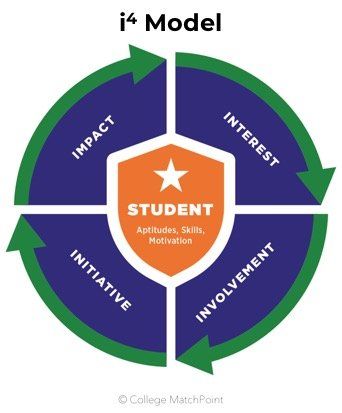This page is licensed under Creative Commons under Attribution 4.0 International. Anyone can share content from this page, with attribution and link to College MatchPoint requested.
Colleges Love Activities (And You Should, Too)
What clubs should I join?
Does this activity count?
Will this look good on my resume?
Am I doing enough?
These questions can plague high school students and their parents as they look ahead to college and try to figure out what might give them an edge on their applications. At College MatchPoint, our students have succeeded by focusing on initiative, impact, and leadership.
Extracurricular activities are of course important—and necessary—when applying to college. But students should steer clear of selecting activities just because they might “look good” on a resume or application. Shallow involvement in a club or activity won’t impress admissions committees; they’re looking for meaningful engagement.
We’ve developed a model from our work with high schoolers which proved to be a useful guide:

The best way for a student to show deep involvement is to choose activities that they are authentically interested in. And remember, activities come in all shapes and sizes, both school-affiliated and otherwise: sports, clubs, community service, hobbies, internships, jobs, academic summer programs...the list goes on. Far less traditional activities—like building a computer, designing and creating clothing, writing original music or fiction, or researching and sharing strategies to protect the bee population—are also great ways to demonstrate a student’s unique skills, talents, and interests. The nature of the activity isn’t nearly as important as its relationship to the student’s personal journey. If a student can demonstrate that they’re passionate about something and striving to deepen their knowledge and engagement, that’s when they’ll stand out from the crowd.
INITIATIVE
Participation is great, but students can really shine by demonstrating initiative: starting with an idea and then taking steps to make it a reality. Traditionally, we might think of initiative as founding a club or starting a new school program. And while those and other formal leadership roles certainly do the trick, there are other ways to show initiative. Here are a few examples:
- Proposing a service project to fellow club members and then reaching out to the organization to coordinate student service
- Making a new playlist and dance routine to add some fun into the daily team warm-up
- Organizing a study group for a particularly tough AP exam and setting a weekly agenda to keep everyone on track
The key is to turn ideas into actions, no matter the context.
IMPACT
Admissions committees love initiative. But something they love even more: when that initiative turns into impact. To identify impact, ask yourself: “what is different because of my student’s involvement/ideas/questions?”
Revisiting the examples of initiative, let’s look at what their impact might be:
- The proposed service project led to ten new members joining the club (thus increasing the potential future impact of service projects)
- Team morale increased and the team went on to come in second in the state championships that year
- Students in the AP study group all scored 5 on their exams
Of course, initiative won’t always lead to impact—and that’s okay—but be sure to follow through on your student’s actions and encourage them to highlight their impact whenever possible.
LEADERSHIP
Student experiences that show leadership are also powerful stand-out pieces. Formal roles like club president and team captain definitely fit the bill, but leadership can be demonstrated in countless ways without holding a traditional leadership position. Any involvement that includes high levels of accountability and increasing levels of responsibility can help expand the student profile. Consider the following examples:
- A student leads the band at church and helps select and arrange music for the service
- A student recruits fellow students to attend a sporting event or pep rally using social media
- A student starts a blog to share fashion trends and tips
The possibilities are endless. Again, the key is to keep track of the details—duties, responsibilities, actions—and include them on the student’s resume and applications.
Here are a few of the tools that our students used:
Interest & Involvement Reflection
High School Year Experiment Canvas


